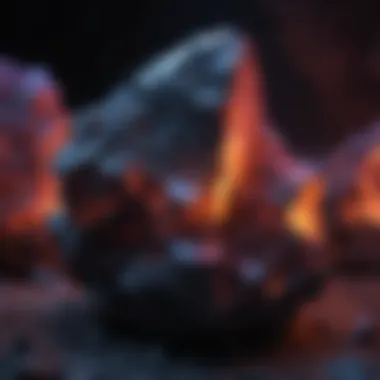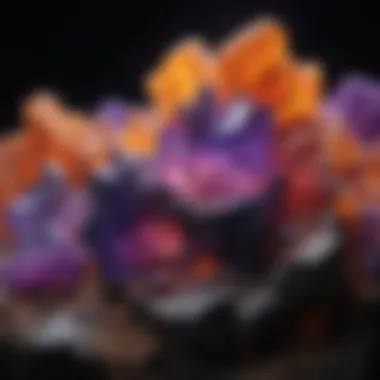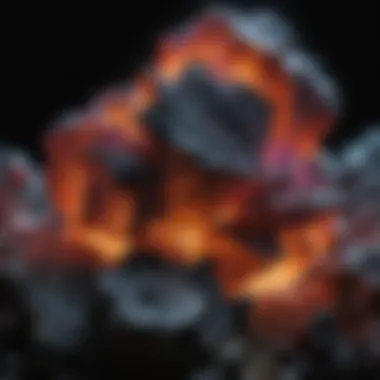The Impact of Black Light on Mineral Discovery


Intro
Black light, also known as ultraviolet (UV) light, plays a crucial yet often underestimated role in the examination of minerals. This engaging article seeks to open up the fascinating world of mineral examination using black light as an essential tool. The very principle behind fluorescence—how certain minerals absorb UV light and then emit it as visible light—adds an extra layer of intrigue to the world of geological science.
Miners and collectors alike find themselves on a treasure hunt not just for rare specimens, but also for the beauty that emerges when these rocks and minerals are immersed in black light. From glowing calcite to vibrant scheelite, the spectrum of colors that can be revealed under such illumination is not only visually striking but also scientifically significant. By understanding the basics of fluorescence and how to use this phenomenon to identify minerals, both enthusiastic collectors and seasoned geologists can elevate their mineral discovery and documentation practices.
Let's delve deeper into the nuts and bolts of rock and fossil identification under black light, which is the key to unlocking the hidden wonders stored within geological treasures.
Understanding Black Light
Understanding black light is crucial for anyone interested in mineral examination, offering insights that can transform standard perspectives into a world awash with hidden colors and unique features. Black light, or ultraviolet (UV) light, acts as a key that can unlock the mysteries within minerals, revealing properties that remain cloaked under normal lighting. By traversing this fascinating intersection of light and mineralogy, collectors, educators, and enthusiasts alike can truly appreciate the intricate beauty of their specimens.
Defining Black Light
Black light refers to ultraviolet light in the spectrum, primarily in the UVA range, which is invisible to the naked eye. It's often used in various contexts, from detecting counterfeit money to forensic science. However, when it comes to minerals, black light reveals a unique phenomenon known as fluorescence. In simpler terms, black light is like the secret agent of the mineral world, exposing the colors and characteristics hidden from everyday view.
How Black Light Works
The operation of black light is based on its ability to excite certain minerals, causing them to emit visible light in response. When this UV light shines on a mineral, it can cause electrons within the mineral's atoms to jump to higher energy states. As these excited electrons return to their normal state, they release energy in the form of visible light. This process often creates astonishing displays of color, which can greatly enhance mineral identification.
The key here is understanding that not all minerals will react similarly under black light. Some might glow with a vibrant hue, while others remain dull. The variation in response hinges on factors such as the mineral's chemical composition and structure.
The Electromagnetic Spectrum Explained
To grasp black light's role in mineral examination, it's essential to consider its position within the electromagnetic spectrum. The spectrum encompasses various types of light rays, spanning from gamma rays to radio waves. UV light lies just beyond the visible spectrum, bridging it with X-rays.
- Gamma Rays: Very short wavelengths, high energy.
- X-rays: Penetrate materials; used in medical imaging.
- Ultraviolet Light: Can be divided into three categories:
- Visible Light: The colors we see, ranging from violet to red.
- Infrared Light: Beyond visible light, often felt as heat.
- UVA (315-400 nm): The longest wavelength UV light, relevant for black lights.
- UVB (280-315 nm): Responsible for causing sunburns.
- UVC (100-280 nm): Germicidal and often used in sterilization.
Understanding where black light resides within this spectrum provides a backdrop to its illuminating capabilities. Knowledge in this area not only assists in identifying minerals but enhances appreciation for their unique qualities.
"The beauty of minerals is not just in their form, but in how they interact with light. Black light reveals what the naked eye often misses."
By engaging with black light and its interactions, one opens a gateway into a more profound exploration of geological wonders. Collectors and enthusiasts can expand their knowledge and refine their techniques, ensuring a deeper connection with nature's hidden treasures.
Fluorescence Phenomena
Fluorescence phenomena play a crucial role in mineral examination, acting like a light switch that can reveal hidden aspects of minerals that might otherwise go unnoticed. For those engaged in geology, whether as professional collectors or hobbyists, understanding fluorescence can open up a world of discoveries. When minerals are exposed to black light, certain elements within them absorb this light and emit it at a different wavelength, often resulting in striking visual displays. This not only aids in identifying minerals but also enhances the appreciation of their beauty.
What is Fluorescence?
Fluorescence refers to the process whereby a substance absorbs photons and then re-emits them. This occurrence happens almost instantaneously—typically within a nanosecond of absorption. The emitted light often appears in vivid hues that contrast beautifully against the backdrop of a dark environment. Unlike phosphorescence, which involves a delayed light emission, fluorescence gives immediate lighting that can astonish anyone looking closely. The implications for mineral examination are significant; a stone may look ordinary under regular light but become utterly captivating beneath black light.
Types of Fluorescence
When discussing fluorescence, it’s essential to distinguish between various types based on the wavelength of light involved. Let's break them down a bit:
Shortwave Fluorescence
Shortwave fluorescence occurs when minerals are exposed to ultraviolet light with shorter wavelengths, typically between 254 and 365 nanometers. This type of fluorescence is notable for its intensity and can reveal intricate details within the mineral structure. For mineral collectors, shortwave fluorescence is a beneficial choice because it often showcases bright colors, making the gemstones even more attractive. However, it requires careful handling as excessive exposure can degrade the mineral over time.
Longwave Fluorescence


In contrast, longwave fluorescence deals with ultraviolet light of longer wavelengths, generally ranging from around 320 to 400 nanometers. The key characteristic of longwave fluorescence lies in its subtler hues, which can sometimes be overlooked. While not as showy as its shortwave counterpart, many valuable minerals react beautifully under longwave light, providing valuable clues for identification. It is a popular choice among collectors who desire a more nuanced viewing experience. However, the less dramatic emission can lead to misidentification if one is not accustomed to observing longwave reactions.
Daylight Fluorescence
Daylight fluorescence adds another layer to the mineral examination process. This type of fluorescence occurs when a mineral exhibits glowing properties under natural sunlight or specific artificial lights that closely mimic daylight spectra. Its significance arises from the practicality it offers in fieldwork, where portable equipment may not always be on hand. Unlike shortwave or longwave, daylight fluorescence allows collectors to instantly assess minerals in their natural environment. Unfortunately, the range of minerals exhibiting this fluorescence can be limited, making it less reliant in some cases.
Factors Influencing Fluorescence
Several factors can impact the fluorescence of minerals, including their chemical composition, impurities, and environmental conditions. For example, the presence of certain trace elements can enhance or completely change the fluorescence characteristics in a mineral. Additionally, temperature can play a role. A warmer mineral may not fluoresce just as vividly as when it is cooler. Understanding these factors is crucial as they can influence a collector’s observations and fieldwork strategies as well.
Fluorescence is not just a visual treat; it's a tool that helps connect the dots in the mineral world, offering insights that extend beyond aesthetics.
Minerals That Glow
The study of minerals that exhibit fluorescence under black light is paramount when examining geology’s hidden treasures. Understanding these minerals not only enriches the experience for collectors and enthusiasts but also unlocks new dimensions in the study and documentation of geological specimens. This section sheds light on the prominent fluorescent minerals, highlighting their distinct characteristics, benefits, and how they contribute to the broader understanding of mineralogical phenomena.
Common Fluorescent Minerals
Fluorite
Fluorite stands out in the realm of fluorescent minerals. Its vibrant colors and distinct properties make it a favorite among hobbyists and collectors. One key characteristic of fluorite is its strong fluorescence, often seen in shades ranging from greens to purples when exposed to black light. This quality not only makes fluorite visually appealing but also valuable for educational purposes.
A unique aspect of fluorite is its ability to display different colors under varying wavelengths of ultraviolet light. For instance, a specimen might appear green under shortwave light and shift to blue under longwave light. This color change phenomenon provides practical advantages for mineral identification and deepens the appreciation of its optical properties. However, it also poses challenges since novice collectors might misinterpret the color variations.
Calcite
Calcite is another mineral that frequently glows under UV light, often detected as a bright white or greenish hue. A striking quality of calcite is its double refraction, meaning that images viewed through it appear doubled. This optical illusion adds to calcite's allure, making it an interesting specimen for both academic study and collection.
What sets calcite apart is its wide availability and diverse forms, ranging from colorful crystal formations to opaque masses. Its glow can be subtle, yet under the right conditions, it can serve as a reliable indicator of the mineral’s presence. The primary downside is its commonality, which may lead to oversaturation in amateur collections. Yet, its role in the scientific understanding of mineral fluorescence remains invaluable.
Smithsonite
Smithsonite is less renowned but equally fascinating. This mineral often showcases soft pastel hues, including pink, blue, and green, making it quite visually appealing. Its hallmark characteristic is its zinc content, which is responsible for its unique coloration and fluorescence. Under black light, smithsonite can emit a bright green or blue glow, which adds an aesthetic dimension that many collectors value.
Smithsonite's distinctive coloring and glow contribute significantly to mineral collections. Its translucent quality allows light to play through its structure, casting ethereal glows that can transform how collectors appreciate their specimens. However, it can be less robust than other minerals, raising concerns about wear and tear during handling, which enthusiasts need to consider for preservation.
Identification of Fluorescent Minerals
Identifying fluorescent minerals involves careful observation and knowledge of their distinct properties. Using black light effectively can unveil their hidden attributes, allowing collectors to enhance their repositories with unique finds. Understanding the nuances of fluorescence, along with the techniques specific to mineral identification, equips enthusiasts with the insights necessary for successful exploration and documentation.
"Fluorescence not only adds beauty but also a layer of complexity to mineral identification that can transform a simple hobby into a nuanced science."
The Utility of Black Light in Mineral Collection
When it comes to the world of mineral examination, the utility of black light cannot be overstated. For rock and fossil collectors alike, this tool transforms how specimens are assessed and appreciated. Through the subtle glow of fluorescence, often invisible under normal light, black light serves not just as a means of identification but also enhances the visual appeal of minerals. Whether you’re a seasoned evaluator or a newcomer to the field, understanding this utility is crucial to refine your collecting techniques and elevate your experience.
Practical Applications
Field Identification Techniques
Field identification techniques using black light can be a game-changer in mineral evaluation. Instead of relying solely on traditional methods like visual inspections or chemical tests, collectors can utilize black light to quickly highlight key features of minerals that otherwise remain dormant under daylight. A particular benefit of this technique is its accessibility; lightweight and portable black lights can be easily carried during field trips.
For example, when searching for fluorite, a mineral notorious for its splendid fluorescence, a black light can reveal the vivid colors that signify quality. The key characteristic of this approach is immediate feedback – immersing the mineral within the glow elucidates unique properties swiftly, allowing for prompt decisions during collection. However, one should be wary of over-relying on fluorescent characteristics. Not all fluorescent minerals are valuable, which may lead to misjudgments if no further analysis is undertaken.


Enhancing Display and Aesthetics
Enhancing display and aesthetics is another practical application of black light in mineral collection. Many enthusiasts take pride in exhibiting their specimens in homes, galleries, or mineral shows. With the strategic use of black light, the display becomes not just informative but visually arresting. The ability to showcase the vivid fluorescence of certain minerals against a dark backdrop captivates observers and elevates the overall aesthetic appeal.
Collectors often set up specialized displays that integrate black lights, which may include cabinets or stands outfitted to highlight the brilliance of the mineral under ultraviolet light. One unique feature of this aesthetic enhancement is the ability to control the environment; dark settings allow the stunning fluorescence to take center stage. However, potential downsides exist. Overexposure to UV light may cause some minerals to fade over time, necessitating careful consideration of display duration or protective measures.
Tools and Equipment
Choosing The Right Black Light
Selecting the appropriate black light is crucial for effective mineral examination. There are various types available, from handheld models to larger stationary setups. Collectors should prioritize options that emit the correct wavelength for their intended use. The key characteristic here is understanding the difference between shortwave and longwave UV lights. While shortwave lights tend to reveal more colors, longwave lights are often easier on the eyes and reveal different fluorescents.
For instance, if you’re primarily focused on examining minerals like calcite or sodalite, a longwave black light may suffice. However, some rarer specimens may only show their true colors under shortwave light. The flexibility in choosing the right model offers advantages but can also become overwhelming for those unfamiliar with technical specifications. Collectors should weigh the advantages, such as functionality and versatility, against the disadvantages, like cost and complexity of use.
Safety Considerations
Safety considerations are paramount when working with black light. Prolonged exposure to UV radiation can be harmful to skin and eyes, making it essential for collectors to adopt protective measures. One key characteristic of responsible usage includes investing in UV protective glasses and ensuring minimal skin exposure while examining or displaying specimens.
Moreover, creating a workspace that limits direct UV exposure is a good practice to promote safe handling. Unique features associated with this safety protocol include understanding the symptoms of UV overexposure, like skin burns or eye fatigue, and acting promptly if they occur. Overall, while black light applications are incredibly useful, safeguarding one’s health significantly enhances the experience for any mineral collector.
Documenting and Preserving Fluorescent Minerals
Documenting and preserving fluorescent minerals is not merely an accessory to collecting; it is an essential part of understanding and enjoying these fascinating specimens. When collectors apply effective documentation methods, it contributes significantly to their knowledge base, and helps in the appreciation of minerals not just as static objects, but as vibrant specimens that change depending on the light source. Furthermore, preserving these minerals ensures future enthusiasts can appreciate their beauty unmuddled by time or environmental impacts.
Recording Observations
When you turn on a black light and watch certain minerals reveal their inner glow, it’s important to pause and take notes. Recording observations extends beyond mere aesthetics; it’s about cataloging features that hold scientific value. As you inspect each specimen, jot down the mineral's characteristics, the specific wavelengths that elicit fluorescence, and any changes that occur under different light sources.
- Details to record:
- Name of the mineral and its source.
- The color of fluorescence under black light.
- Any physical changes observed, like texture or clarity.
- Date and location of the observation.
These records can come in handy when sharing findings within communities, or documenting a personal collection for future generations. The more detailed the account, the better it contributes to both your personal understanding and to the collective knowledge of mineral enthusiasts everywhere.
"Every collector’s notes can be a bridge to fresh understanding—a way to share what they’ve observed with other kindred spirits."
Preservation Techniques
Preserving fluorescent minerals begins not with the display, but at the moment of collection. First, ensuring that minerals are properly cleaned without harsh chemicals is crucial. Gentle soap and water usually do the trick. Avoid exposing them to extreme temperatures or direct sunlight, as those factors can dull their luster and fluorescence.
Once cleaned, consider the following preservation methods:
- Safe Storage:
Store minerals in acid-free containers or padded boxes to protect against scratches. Jewel cases can also be a smart choice, as they allow you to show off your treasures while keeping them safe. - Controlled Environment:
Maintain a stable environment in terms of humidity and temperature—high humidity can lead to mineral degradation over time. - Documentation Labels:
Attach labels to your minerals that note critical information, such as their origin and any notable characteristics. Using archival-quality materials ensures that the ink doesn't fade. - Photographic Records:
Alongside written observations, take high-quality photos under various light conditions. It helps capture how a mineral appears in different lighting, which can be vital for comparitive analysis.
By implementing these techniques, collectors can look forward to enjoying their glowing specimens for years to come, providing a sense of continuity for future explorations into the world of minerals.
Challenges in Using Black Light
Understanding the challenges that come with using black light in mineral examination is vital for anyone engaged in this fascinating area of study. While black light can reveal stunning fluorescent properties of minerals, it is not without its limitations and potential pitfalls. Recognizing these challenges enhances the effectiveness and reliability of mineral identification techniques, ensuring that collectors and geologists make informed decisions in the field.
Limitations of Black Light Inspection
When employing black light for mineral inspections, several limitations should be considered:


- Type of Fluorescence: Not all minerals fluoresce under black light, meaning collectors might miss key specimens. Different minerals react differently, and some might not exhibit any fluorescence at all.
- Environment Interference: Ambient light conditions can greatly affect black light effectiveness. Bright surroundings might obscure the fluorescent glow, leading to incorrect conclusions about a mineral’s properties.
- Switching Wavelengths: The desired fluorescence might only occur under specific wavelengths. Not having the right black light setup can lead to false assumptions during investigations.
The interplay of these factors means that while black light is a useful tool, it should be used with an understanding of its constraints.
Avoiding Misidentification
Misidentification can be a significant concern when using black light for mineral examination. To avoid falling into this trap, consider the following strategies:
- Cross-Reference Properties: Always cross-check the mineral's physical properties, such as hardness, color, and luster, with all available documentation. This multi-faceted approach ensures a more accurate identification.
- Use Multiple Light Sources: Employing different types of light, including natural light, can help differentiate between fluorescent minerals and minerals that may simply appear similar under black light.
- Seek Expert Advice: If ever in doubt, consult specialized forums or experts. Online communities, such as those found on Reddit or Facebook, often have knowledgeable individuals who can offer insights based on their experiences.
“One peek under the black light can be deceiving; it’s the thorough investigation that reveals the truth.”
By maintaining a comprehensive approach that includes both technology and knowledge, collectors can significantly reduce instances of misidentification, ensuring a richer and more rewarding mineral examination experience.
Future of Black Light Applications in Geology
The potential of black light in geology is only beginning to be tapped, yet its significance is already apparent. With the advancement of technology and a growing interest in mineralogy, the future applications of black light promise to enhance not just identification but also the understanding of mineral properties. As more researchers and collectors harness its capabilities, we will likely see considerable innovations in this field.
Emerging Technologies
As we gaze into the horizon of geology-related advancements, several trends stand out. The development of portable black light units is one such innovation. These new devices are not only lightweight but also offer improved energy efficiency, enabling mineralogists to conduct fieldwork for extended periods without needing to recharge or replace batteries frequently. Additionally, advancements in LED technology have allowed more targeted wavelengths, enhancing the visibility of specific fluorescence in minerals.
Another promising avenue is the integration of imaging technology with black light applications. High-resolution cameras equipped to capture fluorescence under black light can provide geologists with detailed imagery that reveals things the naked eye would overlook. This could improve accuracy in mineral identification and classification, giving researchers an edge in both field studies and lab environments.
"The future isn't something we enter. The future is something we create."
- Leonard I. Sweet
Moreover, developments in software for analyzing fluorescence data are also on the rise. By harnessing machine learning algorithms, researchers can analyze large datasets to uncover patterns in mineral fluorescence that would have taken years to decipher manually. This synergy between hardware and software bodes well for the future of mineral classification.
Expanding Research Frontiers
With the door wide open for new insights, the research frontiers of using black light in geology are expanding rapidly. The biomedical field's growing interest in fluorescence has brought useful techniques that can be adapted to mineral studies. Research into why certain minerals fluoresce can unlock secrets about their formation and history, connecting geological processes with environmental changes. This interdisciplinary approach promises to enrich the geological narrative.
New research initiatives are also examining the impacts of human activity on mineral fluorescence. As industrialization encroaches on natural landscapes, understanding how minerals react to pollutants and climate change through fluorescence can be critical in conservation efforts. This knowledge has the potential to inform both policy and practical management of geological resources.
Furthermore, the collaboration between various scientific domains—like geology, chemistry, and environmental science—is on the rise. This means that knowledge derived from black light studies can intertwine with other disciplines, creating a more holistic view of earth sciences and its complexities.
In sum, the future of black light applications in geology holds great promise. The combination of emerging technologies and expansive research will likely pave the way for groundbreaking discoveries. As researchers and enthusiasts continue to explore the depths of what black light can reveal, the potential for new insights and advancements are only limited by the imagination.
Ending
The fundamental role of black light in the examination of minerals cannot be overstated. This particular light source acts as an illuminating companion for collectors and educators alike. Throughout this article, we have traversed numerous aspects of black light's significance, including fluorescence phenomena and the distinct characteristics of minerals that respond under this light. Each section of the write-up sheds light—pun intended—on how enthusiasts can better understand and appreciate their geological treasures.
Summarizing Key Insights
To cap it all off, here are a few key insights:
- Fluorescence provides critical information regarding a mineral's identity; the colors emitted can often reveal its composition.
- Diverse Mineral Responses: Different minerals react uniquely to black light, from the vibrant hues of fluorite to the subtle glimmers of calcite. Recognizing and interpreting these colors significantly enhances collection efforts.
- Tools of the Trade: The assessment of minerals isn’t complete without the right equipment. Choosing the most suitable black light can make all the difference in field examination.
- Potential Pitfalls: It's important to be aware of the challenges and limitations when relying on fluorescence to avoid misidentifying specimens.
These insights form the backbone of effective mineral examination, enhancing both personal collections and educational narratives.
Encouraging Exploration
Diving deeper into the world of black light opens the door to limitless possibilities. For rock and fossil collectors, understanding how to effectively use black light not only enriches your collection but also augments your narrative about each specimen. There’s a world beyond the naked eye, waiting to be explored. When you find yourself in the field, quiz yourself about the minerals you encounter. Ask questions like: How would this glow? What hues might it emit?
Moreover, consider the implications of your findings on broader geological research. As technologies improve, so will the methodologies behind using black light in mineral identification.
In sum, the exploration of black light's use in mineral examination is both a science and an art, demanding a keen eye, curiosity, and creativity from every enthusiast. Dive in and let your understanding glow.







